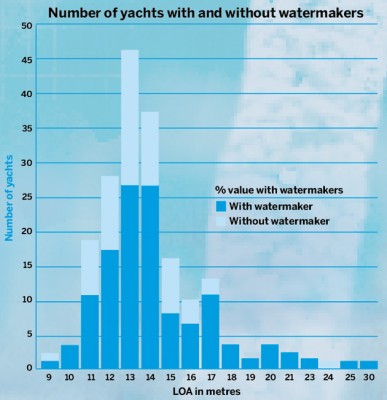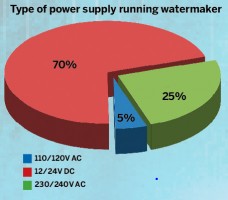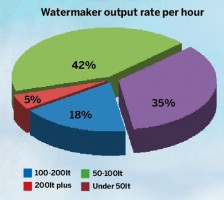Storing, rationing and making fresh water on board is a key concern when you're making an Atlantic crossing. Toby Hodges asks 193 skippers on the ARC for their tips
Watermakers – how making water has become tops for comfort
In our Atlantic Gear Surveys a watermaker has long been rated one of the most useful gear items to fit for an Atlantic crossing. It’s not essential, but can certainly make a crucial difference in terms of comfort aboard. Try telling crew they can only shower once a week and see how quickly they jump ship, for example.
Watermakers consistently make the top three on the wishlist of long-distance cruisers. Over the last few years of our survey, we have seen an increase to the point where they are now regularly carried by 60 per cent of the fleet.
Developments in compact, low-power DC units that can be run from house batteries, have increased the instance of watermakers used on smaller yachts. But watermakers are a serious investment, with prices typically starting from £3,000-£5,000. Choosing the right type to suit your needs, as well as ensuring a sound installation that’s tested well in advance of an offshore passage, are critical factors.
How a watermaker works
Watermakers turn salt water into drinking water using reverse osmosis. They pump seawater through a rolled-up semi-permeable membrane at high pressure to filter out the salt molecules and produce fresh water. The membrane blocks the large salt molecules, creating a small amount of fresh water and discharging the rest as brine.
The pressure required is achieved using a belt off the engine or AC or DC power. Traditional watermakers use high-pressure pumps to generate the required 56-bar, whereas the new generation use a low-pressure pump and achieve the added pressure via hydraulics, hence require less power and installation space – generally for a lower output.
Installation is key. Keep them as low as possible, advises Mactra Marine’s watermaker agent, Jim Macdonald (see below). The siting of the forward-facing scoop is critical, as is keeping the pump as close to sea level as possible. Watermakers need an uninterrupted supply of water, without air bubbles caused by turbulence or air being sucked in when the boat rolls.
How they performed
Sailors increasingly seem to expect to push a button and for their machinery always to work. If installed correctly and run in the perfect environment, a watermaker will perform fantastically, but the ocean creates many variables.
Patrick Farrell, skipper of the Beneteau Oceanis 411 Reservoir Dogs, advises that you need to know your watermaker inside out, saying in hindsight, they would “attend a one day seminar in servicing and repairing watermakers”.
If a watermaker works and delivers it receives the highest praise. Otherwise, it can prove a real headache, as crew try to solve its complexities in an uncomfortable environment (in a locker or below a berth).
Something to bear in mind in our survey: ratings for watermakers can usually be linked to how well the unit has been installed – either by the skipper or, in two-thirds of cases, professionally by an agent. From our 2014 survey results we counted only four or more of the same makes to ensure the result is statistically valid. As each manufacturer produces a wide range of models, there were not enough of the same individual types to make direct comparisons.
Popular brands
The US-made Spectra watermaker is a consistently popular brand, simple and reliable, and these were carried by the most yachts on last year’s crossing (25). The comments matched the reasonable scoring: generally commendable, with a couple of reliability issues. “No problems, made approx 1,000lt. Usage approx 50lt/day for four people,” reported Allures 45 skipper Adrian Evans.
“It gave 2-3 hours a day of watermaking,” said Michael Bull, who gave a faultless rating of his Ventura 150 model on their Sabre 386. “We usually run engine for power – good water supply for three on board.”
However, fellow American Thane Paulsen said of the same Ventura 150, professionally installed on his Bavaria 39 in 2006: “We have invested a couple of thousand dollars in parts and labour over the last 1.5 years to get it running (expensive water!) – but it runs well when it’s working.”
Dessalator was the second most popular brand in terms of numbers carried (23). Comments received about the French-made systems, available in AC, DC or Duo models, were generally praise. “Performance is better than specs of 160lt/hour. More like 180-200lt/hour,” reported Jean Metz of the D160 on his Amel 54. Miss Liz II’s David Johnson said something similar about the D60 on his Hanse 505: “Produced 50-60lt/hr every time, very reliable.”
“Very pleased with Advanced Yacht and the watermaker,” said David Caldow, skipper of Hallberg-Rassy 39 Anika, of his D60 and the agents who installed it, calling them experts who listen rather than try to sell.
The Norwegians on Zera, a Jeanneau SO 469, rated their D60 “good, but poor under higher speed due to air being sucked in”. The fact that it was only installed in May 2014 suggests the possibility that it may not have been tested thoroughly prior to their voyage.
Katadyn are a Swiss brand of watermakers that also sell hand-operated survival units. Comments and ratings from the 17 yachts carrying a Katadyn revolved around the high efficiency of the compact units, and the support and service provided, particularly from UK dealer Mactra Marine.
“Very good. Run most days to keep up with our needs. Low energy use so can run off solar,” reported Simon Pickard of the PowerSurvivor 80E installed on his Hanse 385 Interlude I. “It should be used every third day to ensure quality,” an Xc42 skipper advised about the same model, and suggests: “Only use with crystal clear seawater.”
The compact and lightweight Italian Schenker models consistently receive an average rating, as they did last year. The skipper of the Humphreys 77 Aglaia scored theirs perfectly though, adding: “Schenker DC unit excellent. Total 70 hours run. Big watermaker not used.” Two skippers of 50-footers praised the support from Mactra Marine. Those who brought the mean score down for Schenker with poor ratings failed to say why.
The UK brand Seafresh (now Cathelco), fitted on many Oysters, was rated well by its eight carriers. “Produces water above speed capacity. Always works and low maintenance,” said Oyster 56 El Mundo. Oyster 53 Aretha rates the installation simply: “It’s Oyster, they are amazing!”
The skippers of five production yachts ranging from 42ft to 49ft all rated their Echotec watermakers as faultless. These are durable modular systems without energy-recovery, so although they consume more power, they are cheaper and easier to install. Echotec’s overall standing was brought down only slightly by average results without comment from two Lagoon skippers.
Finally, the robust German Aquatec watermakers, made by yachtsman Joachim Matz, were rated very highly by three out of the five carriers that scored them. Unfortunately there were not sufficient ratings to justify their inclusion in our overall standings.
More power!
A common complaint of those with watermakers is not having enough power to run them. Nearly half the number of watermaker carriers decided to increase their battery capacity on installation. After the crossing, the Lagoon 450 Ripples II declared they wanted more solar panels and the crew of the Swan 46 MkII Milanto even wanted a second generator to help provide power.
The skipper of the Starlight 39 Exody would even “fit a higher output watermaker and a second tank”. They had only one tank, under 300lt, and took less than 30lt of bottled water. With four aboard for the ARC+, they had to ration their water use strictly, stipulating one shower each per leg. The few watermaker owners who weren’t happy with their system said they would upgrade to another to gain higher output.











